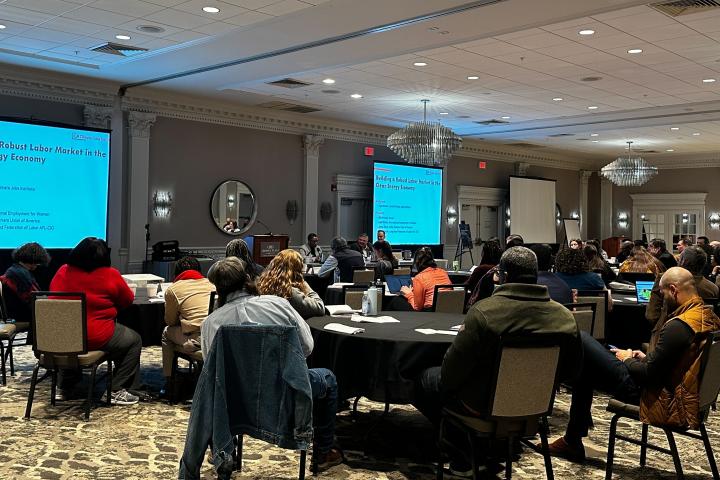Executive Summary
With this report, CJI addresses another core aspect of tackling the dual crises of climate change and inequality: ensuring that frontline, historically underserved communities have expansive, effective pathways into high-quality union clean energy careers.
The Inflation Reduction Act and the Infrastructure Investment and Jobs Act have brought increased attention to two important clean energy workforce questions. First, does the US have enough trained workers to meet the demands of the clean energy economy? And second, how do we ensure that the clean energy workforce is diverse and inclusive?
This report responds to both of these questions by showing that there are model programs across the U.S. that create pathways for underserved communities into apprenticeship readiness, union apprenticeship programs, and ultimately, good union careers.
This study, as well as our many years of experience in the field, have taught us that there is no simple or easy solution to creating or scaling successful pathways. These pathways exist in an ecosystem of essential and interdependent actors that must be focused on the common goal of building a diverse, equitable and unionized clean energy workforce.
Key actors and components include:
- union-led climate coalitions advocating for bold, equitable climate action
- policymakers implementing ambitious, jobs-led climate policy
- strong labor and equity standards that ensure clean energy jobs are good union jobs
- high-quality union apprenticeship programs that pay apprentices well and make sure that the clean energy workforce is highly-skilled and well-trained
- trusting partnerships between labor unions, environmental justice organizations, community groups, employers, MWBE contractors, government, and academic institutions
- high-quality apprenticeship readiness programs that provide participants with the support they need to successfully enter union apprenticeship


Best Practices in Operating Successful Apprenticeship Readiness Programs
- Industry-Driven Programming Tied to Demand: The unionized construction industry is unique in many respects. Programming should align with the realities of this industry and ensure program participants understand how the industry operates.
- The Right People at the Table: Successful programs center their main goal—expanding opportunities to high-quality construction careers—and work relentlessly to recruit parties that need to be involved to drive success. Common stakeholder groups include construction employers, building and construction trades unions, and a blend of government agencies and community-based organizations.
- Shared Infrastructure Amongst Partners: Once the right parties are at the table, they should share resources to maximize impact. These resources can take multiple forms. They can be physical, like tools and classroom space; human capital, like donated staff time for instruction; or relational, like access to community contacts to enhance recruitment.
- Clarity About Populations Served: Given finite resources, programs can rarely cast as wide of a net as they would like. Identifying a key population to serve, and focusing resources on doing that work effectively, is typically a winning strategy.
- Credible Messengers: The most effective program evangelists are often programs’ own graduates. Building a roster of graduates and people from similar backgrounds who are willing to share their experiences and spread the word about career opportunities can encourage recruitment and retention.
- Clear Metrics of Success and Data Tracking: Each program described in this report uses a set of metrics to gauge effectiveness. Popular measures include program graduation rates, apprenticeship or job placement rates, and participant demographics. However, leaders should avoid becoming overly dependent on data; overreliance can lead to inflexibility when adapting to changing circumstances in the field.
- Funding that Best Serves Participants’ Needs: Granting participants financial support is critical, but not every population needs the same type of support. Whether stipends, travel vouchers, daycare services, or other supports, programs should prioritize participants’ unique needs and offer financial assistance that best meets those demands.
- Sustainable Funding Models: Successful programs provide highly personalized services. Substantial amounts of money and staff time are thus required. There is no one-size-fits-all approach to fundraising. Regardless of funding strategies, effective programs seek to secure sustainable funds to run their organizations for the long term.
Recommendations for Key Parties
Organized Labor
______________________________
- Establish Direct Entry Relationships with Apprenticeship Readiness Programs: Apprenticeship applicants with no prior connections may struggle to navigate the application processes and timelines for different trades. Upon establishing a direct entry agreement with an apprenticeship readiness program, unions can offer qualified graduates a more direct path into the trade of their choice. Graduates can then bypass the often lengthy waiting lists for entry.
- Work with Apprenticeship Readiness Organizations to Better Track Apprenticeship and Career Outcomes: Data tracking is important for apprenticeship readiness programs, but it frequently stops after an apprenticeship placement. Organized labor can help track longer-run retention and career advancement statistics, giving all parties richer data by which to judge their effectiveness at diversifying the industry and providing long-term career opportunities.
- Incorporate Apprenticeship Readiness into an Overall Organizing Strategy: Apprenticeship readiness is not a panacea. The construction industry is a complicated ecosystem with many parts that must move together. To have maximum impact, apprenticeship readiness should be part of a larger organizing strategy that includes multiple avenues for bringing in new members and building trust with existing members.
Construction Employers
______________________________
- Create Employment Pathways for Graduates: Apprenticeship readiness is only effective if apprenticeship and job placement opportunities are available for graduates. Direct entry allows organized labor to open space for program graduates, but employers must also prioritize creating job opportunities for those individuals. This goal can be realized through various means: committing to local hiring, funding workforce development programs, and setting strong diversity standards through project labor agreements, collective bargaining agreements, and other avenues.
Community Organizations
______________________________
- Enter New Partnerships: Community organizations often have complicated relationships with employers and organized labor. If an apprenticeship readiness program meaningfully includes community organizations in decision-making structures, values these parties’ input and expertise, and shows real dedication to diversifying the construction industry, then community organizations’ participation can be transformative for the industry and community alike. Keeping an open mind when engaging with new partners can make all the difference.
Organized Labor, Construction Employers, and Community Organizations
______________________________
- Prioritize Providing Time and Resources: This recommendation cuts across the three types of organizations outlined above. Although it may seem obvious, dedicating time and resources to tasks that many view as outside the scope of everyday work can be immensely difficult. Yet one could argue that apprenticeship readiness is essential to all parties’ long-term success and deserves substantial investment.
Policymakers
______________________________
- Invest in Growing Key Industries Like Clean Energy: Apprenticeship readiness programs can only succeed in a robust construction market. A thriving market guarantees labor demand, opening more apprenticeship slots and driving employers to bid on jobs and hire more workers. Policymakers can help maximize these programs’ effectiveness by investing in key industries—and, in turn, creating a pipeline for graduates into registered apprenticeship programs and onto job sites. Clean energy, energy efficiency, public transit expansion, and climate resilience projects should get top investment priority.
- Include Strong Labor and Equity Standards on All Publicly Funded Projects: When government entities provide money or incentives for project development, policymakers have opportunities to attach labor and equity requirements as conditions for receiving funds. Any public investments in projects—whether in clean energy or more broadly—should come with wage floors, apprenticeship utilization mandates, targeted hiring goals, and other measures to guarantee high-quality jobs and equitable access.
- Require “Labor Voice” on Workforce Development and Other Public Boards: To make sure workers’ interests are represented at all levels of government, policymakers can require “labor voice”—or a representative from organized labor—on decision-making boards covering topics such as workforce development, energy and energy efficiency, construction, and economic development. Policymakers can also establish “just transition” boards and require voices from both organized labor and community organizations.
- Provide Adequate, Flexible Funding for Programs: Robust public funding enables programs to expand their footprint without sacrificing quality. But money should not come with too many strings attached. Successful programs allocate resources based on their knowledge of specific communities and what participants need to succeed. Policymakers should follow the lead of apprenticeship readiness practitioners and avoid cumbersome requirements that ultimately detract from the work at hand.
Private Funders
______________________________
- Make Longer-Term Commitments to Fund Work: The transitory nature of foundation-based and philanthropic funding is a major source of stress for nonprofit leaders. In a field like apprenticeship readiness, where it takes time to build relationships and identify the main players in an industry, year-to-year funding can greatly impede program creation. Private funders can experiment with longer-term funding commitments, freeing workforce development practitioners to do what they do best: analyze the industry, establish relationships, and develop programs that will have long-term impacts.
- Institute Flexible Metrics for Success: Similar to public funders, philanthropies can follow the lead of practitioners when determining the appropriate use of funds and metrics for success. Programs should set measurable goals, track progress, and use data to inform practice. However, these aspects must be balanced with reasonable exceptions to accommodate on-the-ground realities. Apprenticeship readiness is meant to familiarize participants with a given industry. Sometimes, people drop out of a program upon discovering it is not a good fit. Attrition may count against graduation rates, but is not necessarily indicative of failure.
- Help Programs to Build Capacity in Key Areas: Nonprofit leaders occasionally struggle to develop the visionary practices and the day-to-day logistics needed for long-term success. Although it is important to fund service provision, investing in long-run capacity building (eg, visioning, strategic planning, coaching, personnel and project management, and data tracking) is also vital.
Report Launch Livestream
CJI launched the "Building an Equitable, Diverse, and Unionized Clean Energy Economy" report on November 30th, 2023, at the Cornell ILR Conference Center in midtown Manhattan. The event kicked off with remarks from:
- Lara Skinner, executive director, Climate Jobs Institute
- Gary LaBarbera, president, Building and Construction Trades Council for Greater New York
- Jessica Ramos, state senator, District 13, Chair of the Senate Committee on Labor
Report co-author Zach Cunningham presented key findings, and co-author Melissa Shetler moderated a panel discussion with the following experts:
- Nicole Bertran, executive vice president, The Edward J Malloy Initiative for Construction Skills
- Chynna Hampton, Climate Jobs Illinois, IL AFL-CIO
- Ken Nim, director, CityBuild, San Francisco
- Jay Rowell, executive director, HIRE360, Chicago
- Nicole Schwartz, executive director, TradesFutures



